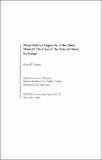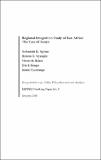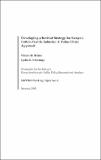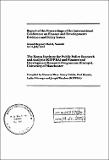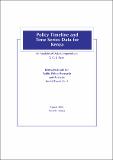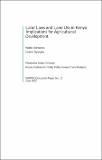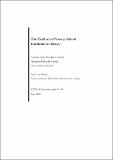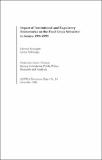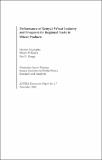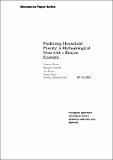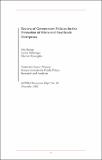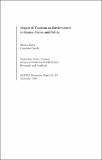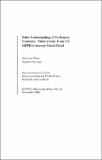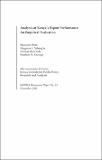3. KIPPRA Research Publications: Recent submissions
Now showing items 661-680 of 709
-
Discussion Paper No. 26 of 2003 on Measuring and Analysis Agricultural Productivity in Kenya: a Review of Approaches
(The Kenya Institute for Public Policy Research and Analysis (KIPPRA), 2003)Concern is rising about the performance of the agricultural sector in Kenya given that it is the backbone of the country’s economy. The issue of particular concern is the declining productivity that has been associated ... -
Discussion Paper No. 29 of 2003 on What Defines Liquidity of the Stock Market? The Case of the Nairobi Stock Exchange
(The Kenya Institute for Public Policy Research and Analysis (KIPPRA), 2003)Liquidity of the stock market is vital if the market is to play a significant role in the development by facilitating mobilisation of long-term capital. During the revitalisation period, a lot of efforts have been made ... -
Working Paper No. 09 of 2003 on Regional Integration Study of East Africa: The Case of Kenya
(The Kenya Institute for Public Policy Research and Analysis (KIPPRA), 2003)This study evaluates the costs and benefits of the East African Community Customs Union to Kenya. In particular, the study assesses the potential impact (to Kenya) of removing tariffs on intra-EAC trade and establishing a ... -
Working Paper No. 10 of 2003 on Costs and Benefits of Eliminating Child Labour in Kenya
(The Kenya Institute for Public Policy Research and Analysis (KIPPRA), 2003)The International Labour Organization approximates that about 250 million children worldwide are involved in child labour, with most children working under harmful conditions; that is in circumstances that are detrimental ... -
Working Paper No. 08 of 2003 on Developing a Revival Strategy for Kenya's Cotton-Textile Industry: A Value Chain Approach
(The Kenya Institute for Public Policy Research and Analysis (KIPPRA), 2003)This study was motivated by the huge potential of Kenya’s cotton-textile sector in poverty reduction, its unprecedented decline since the second half of the 1980s and the market opportunities offered by African Growth and ... -
Conference Proceeding No. 02 of 2002 on the Report of the Proceedings of the International Conference on Finance and Development: Evidence and Policy Issues
(The Kenya Institute for Public Policy Research and Analysis, 2002)A lot of research has been done in finance and development with the aim of establishing the direction of causality. This effort has been necessitated by the fact that important links exist between finance and ... -
Special Report No. 03 of 2002 on Policy Timeline and Time Series Data for Kenya: an Analytical Data Compendium
(The Kenya Institute for Public Policy Research and Analysis (KIPPRA), 2002)There have been various efforts at publishing an extended time series of data for Kenya. These efforts have had a dual aim. First was to make available, in one convenient location, data that would otherwise need to be ... -
Occasional Paper No. 03 of 2002 on Agriculture, Economic Growth and Poverty Reduction
(The Kenya Institute for Public Policy Research and Analysis (KIPPRA), 2002)Reducing poverty is a primary focus of public policy in most developing countries, a fact that is underscored by the recent emphasis on the formulation of Poverty Reduction Strategy Papers (PRSPs) by African governments, ... -
Occasional Paper No. 04 of 2002 on Post-Doha African Challenges in the Sanitary and Phytosanitary and Trade Related Intellectual Property Rights Agreement
(The Kenya Institute for Public Policy Research and Analysis (KIPPRA), 2002)The World Trade Organization agreements on sanitary and phytosanitary (SPS) and Trade Related Intellectual Property Rights (TRIPS) present various challenges and opportunities for sub-Saharan African countries to expand ... -
Discussion Paper No. 15 of 2002 on Land Laws and Land Use in Kenya: Implications for Agricultural Development
(The Kenya Institute for Public Policy Research and Analysis (KIPPRA), 2002)Land is both a ‘social’ and economic asset. As an economic asset, land works either as a financial tool or production tool. Land as a production tool is essential in production of agricultural goods. At the same time, land ... -
Discussion Paper No. 14 of 2002 on the Decline in Primary School Enrolment in Kenya
(The Kenya Institute for Public Policy Research and Analysis (KIPPRA), 2002)Since independence in 1963, Kenya has invested substantial resources in education. For almost three successive decades, these investments and other government policies led to impressive gains in educational access at all ... -
Discussion Paper No. 18 of 2002 on Impact of Institutional and Regulatory Frameworks on the Food Crops Subsector in Kenya: 1990-1999
(The Kenya Institute for Public Policy Research and Analysis (KIPPRA), 2002)This paper focuses on policy, institutional and regulatory reforms in the food crops sub-sector: maize, wheat and rice. Reforms in this subsector were expected to enhance market coordination and control, in addition to ... -
Discussion Paper No. 17 of 2002 on Performance of Kenya's Wheat Industry and Prospects for Regional Trade in Wheat Products
(The Kenya Institute for Public Policy Research and Analysis (KIPPRA), 2002)Wheat is the second most important food crop in Kenya. Wheat production has however declined over the years due to high production costs, high capital costs, lack of credit for production, and the low level of ... -
Discussion Paper No. 12 of 2002 on Predicting Household Poverty: A Methodological Note with a Kenyan Example
(The Kenya Institute for Public Policy Research and Analysis (KIPPRA), 2002)Identifying and measuring poverty require data on economic conditions of households and individuals. Such data are typically gathered through household surveys. Household surveys collect data on demographics, incomes, ... -
Discussion Paper No. 20 of 2002 on Review of Government Policies for the Promotion of Micro and Smallscale Enterprises
(The Kenya Institute for Public Policy Research and Analysis (KIPPRA), 2002)The Micro and Smallscale Enterprises' (MSEs) sector in Kenya has grown tremendously over the last two decades despite poor policy conceptualization and implementation in the sector. However, this growth is characterized ... -
Discussion Paper No. 19 of 2002 on Impact of Tourism on Environment in Kenya: Status and Policy
(The Kenya Institute for Public Policy Research and Analysis (KIPPRA), 2002)Tourism is a leading economic activity in Kenya, being the third largest foreign exchange earner after tea and horticulture. Since the 1990s, particularly the second half of the decade, Kenya’s tourism industry has faced ... -
Discussion Paper No. 16 of 2002 on Better Understanding of the Kenyan Economy: Simulation from the KIPPRA-Treasury Macro Model
(The Kenya Institute for Public Policy Research and Analysis (KIPPRA), 2002)Since the pioneering work of Tinbergen in the late 1930s, the use of macroeconomic models as vital instruments for policy analysis has gained considerable interest. Based on historical behaviour of an economy, an ... -
Discussion Paper No. 22 of 2002 on Analysis of Kenya's Export Performance: An Empirical Evaluation
(The Kenya Institute for Public Policy Research and Analysis (KIPPRA), 2002)With globalisation, export-led growth strategy has become a major focus for many countries including Kenya. Although there have been efforts towards diversification of the export sector, Kenya’s exports are still dominated ... -
Discussion Paper No. 21 of 2002 on Tobacco Excise Tax in Kenya: an Appraisal
(The Kenya Institute for Public Policy Research and Analysis (KIPPRA), 2002)Excise taxes form a substantial proportion of revenue for governments all over the world, and especially in low-income developing countries. Excise taxes are levied on a few goods characterised by low price elasticity ... -
Discussion Paper No. 13 of 2002 on Human Capital Externalities and Returns to Education in Kenya
(The Kenya Institute for Public Policy Research and Analysis (KIPPRA), 2002)This study has used micro data to analyse the effect of human capital externality on earnings and returns to education. The parameters of the earnings function are estimated using the ordinary least squares method. The ...


